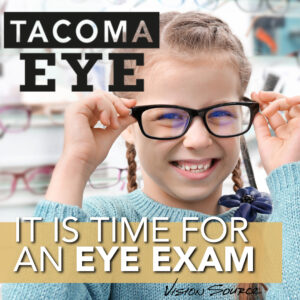👓 What Is Digital Eye Strain?
 Digital eye strain is a collection of symptoms that develop after extended use of screens.
Digital eye strain is a collection of symptoms that develop after extended use of screens.
In kids, this often looks like:
- Blurry vision after reading or computer use
- Headaches
- Eye fatigue
- Difficulty concentrating on homework
- Dry, irritated eyes
- Trouble sleeping when devices are used before bed
These symptoms don’t necessarily mean your child has a vision problem-but it’s a signal that their eyes are working harder than they should.
💡 The Role of Blue Light
Digital devices emit blue light, a short wavelength of light that scatters more easily and may contribute to eye strain. Current(as of Sept 2025) research shows that blue light from screens is not likely to cause permanent eye damage, it can affect:
- Sleep patterns: Blue light exposure in the evening can suppress melatonin, making it harder for kids to fall asleep.
- Comfort: Some children are more sensitive to the flicker and glare of LED screens, which trigger headaches or eye strain.
🟠 What About FL-41 Tint?
One solution some eye doctors recommend is FL-41 tinted lenses. Originally developed for patients with light sensitivity and migraines, FL-41 filters certain wavelengths of light that can trigger discomfort.
Studies suggest FL-41 may help reduce digital eye strain symptoms like:
- Headaches from prolonged screen time
- Light sensitivity
- Fatigue related to glare
While not every child needs tinted lenses, they can be especially helpful for those with frequent headaches or sensitivity to light during homework or device use.
✅ Tips for Parents: Protecting Your Child’s Eyes
The good news is, there are simple ways to help reduce digital eye strain for students of all ages:
1. Try the 20-20-20 Rule
Every 20 minutes, encourage your child to look at something 20 feet away for 20 seconds. This relaxes the focusing muscles in the eyes and prevents fatigue.
2. Adjust Screen Setup
- Keep the screen about arm’s length away.
- Position the screen slightly below eye level.
- Reduce glare by adjusting room lighting and avoiding direct overhead lights.
3. Encourage Blinking
Kids tend to blink less when using devices, which can lead to dry eyes. A gentle reminder to blink helps keep the eyes moist and comfortable.Artificial tears (without preservatives) can help eye comfort at any age.
4. Limit Evening Screen Time
Encourage “device-free” time at least 1 hour before bed. This reduces blue light exposure and supports healthier sleep patterns.
5. Consider Protective Lenses
Talk with your optometrist about options such as:
- Blue light-filtering lenses
- FL-41 tinted lenses for children with light sensitivity or frequent headaches
6. Get Outdoors
Research has shown spending 60-90 minutes outdoors can help reduce the risk of a child developing Myopia
7. Get Regular Eye Exams
Sometimes what looks like digital eye strain is actually an uncorrected vision problem. Annual eye exams ensure that your child has the right prescription and can see clearly for both classroom and screen learning.
🌟 Final Thoughts
Screens have become a large part of learning in today’s digital world-but that doesn’t mean your child’s eyes have to suffer. With healthy screen habits, the right lens solutions, and regular check-ups, you can help protect their vision and keep homework time more comfortable.
If your child has been complaining of headaches, eye strain, or trouble with homework, schedule an eye exam with us. We’ll help determine if they need a new prescription, specialized lenses, or just a few adjustments to their daily routine.”